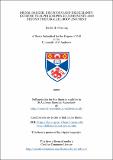Files in this item
Drugs, danger, delusions (and Deleuzians?) : extreme film-philosophy journeys into and beyond the parallel body and mind
Item metadata
| dc.contributor.advisor | Martin-Jones, David | |
| dc.contributor.author | Fleming, David H. | |
| dc.coverage.spatial | iii, 220 p. | en_US |
| dc.date.accessioned | 2010-09-13T10:46:29Z | |
| dc.date.available | 2010-09-13T10:46:29Z | |
| dc.date.issued | 2009-11-23 | |
| dc.identifier.uri | https://hdl.handle.net/10023/985 | |
| dc.description.abstract | Drugs, Danger, Delusions (and Deleuzians?) opens up a philosophical investigation into a series of ‘extreme’ mind and body films drawn from different historical contexts. Through two sections and four distinct chapters, cinema is explored as an agent of becoming that allows viewers to think and feel in an affected manner. Investigating a broad spectrum of extreme narratives focusing on drugs, hooligan violence, insomnia and madness, the project provides a focused historical understanding of the films’ affective regimes and aesthetic agendas. The different lines of flight and escape explored on-screen all somehow appear to spiral around the same issues, concepts, ideas and philosophies. Utilising the cinematic theories of Gilles Deleuze along with his philosophical work co-authored with Félix Guattari, the thesis aims to investigate a range of related films, that in the extreme, reveal underlying models of an integrated or parallel mind and body and immanently embedded identity; wherein the concept of a stable and fixed being is replaced by that of a fluid becoming. All chapters investigate how immanently embedded characters embark upon extreme or dangerous lines of escape, where the reinvention of living and thinking is explored and made visible. The first section investigates a range of ‘head-films’ that take the mind as their theme, but are found to plicate and expand consciousness into the parallel body. The second section investigates extreme body films that push the sensory-motor schema to its limits so that thought, perception and consciousness become affected. The two interrelated sections investigate how the films and filmmakers employ different regimes of mind and body cinema to aesthetically convey and relay these concepts to the spectator. The project thus strives to develop Deleuzian paradigms beyond their original scope to explore parallel-image regimes and sequences that allow spectators to think and feel the films’ underlying philosophical concepts and positions. | en_US |
| dc.language.iso | en | en_US |
| dc.publisher | University of St Andrews | |
| dc.rights | Creative Commons Attribution-NonCommercial-NoDerivs 3.0 Unported | |
| dc.rights.uri | http://creativecommons.org/licenses/by-nc-nd/3.0/ | |
| dc.subject | Deleuze | en_US |
| dc.subject | Extreme body or brain cinema | en_US |
| dc.subject.lcc | PN1995.F64 | en_US |
| dc.subject.lcsh | Motion pictures--Psychological aspects | en_US |
| dc.subject.lcsh | Altered states of consciousness | en_US |
| dc.subject.lcsh | Mind and body in motion pictures | en_US |
| dc.subject.lcsh | Deleuze, Gilles--Views on motion pictures | en_US |
| dc.subject.lcsh | Experimental films--History and criticism | en_US |
| dc.title | Drugs, danger, delusions (and Deleuzians?) : extreme film-philosophy journeys into and beyond the parallel body and mind | en_US |
| dc.type | Thesis | en_US |
| dc.type.qualificationlevel | Doctoral | en_US |
| dc.type.qualificationname | PhD Doctor of Philosophy | en_US |
| dc.publisher.institution | The University of St Andrews | en_US |
| dc.identifier.doi | https://doi.org/10.17630/10023-985 |
This item appears in the following Collection(s)
Except where otherwise noted within the work, this item's licence for re-use is described as Creative Commons Attribution-NonCommercial-NoDerivs 3.0 Unported
Items in the St Andrews Research Repository are protected by copyright, with all rights reserved, unless otherwise indicated.


